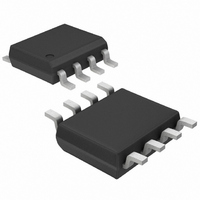MAX515CSA+T Maxim Integrated Products, MAX515CSA+T Datasheet - Page 10

MAX515CSA+T
Manufacturer Part Number
MAX515CSA+T
Description
IC DAC 10BIT VOLT OUT 8-SOIC
Manufacturer
Maxim Integrated Products
Datasheet
1.MAX515CSA.pdf
(16 pages)
Specifications of MAX515CSA+T
Settling Time
25µs
Number Of Bits
10
Data Interface
Serial
Number Of Converters
1
Voltage Supply Source
Single Supply
Operating Temperature
0°C ~ 70°C
Mounting Type
Surface Mount
Package / Case
8-SOIC (3.9mm Width)
Lead Free Status / RoHS Status
Lead free / RoHS Compliant
Power Dissipation (max)
-
The serial output, DOUT, allows cascading of two or more
DACs. The data at DIN appears at DOUT, delayed by 16
clock cycles plus one clock width. For low power, DOUT is
a CMOS output that does not require an external pull-up
resistor. DOUT does not go into a high-impedance state
when CS is high. DOUT changes on SCLK’s falling edge
when CS is low. When CS is high, DOUT remains in the
state of the last data bit.
Any number of MAX504/MAX515 DACs can be daisy-
chained by connecting the DOUT of one device to the DIN
of the next device in the chain. For proper timing, ensure
that t
The MAX504 is configured for a gain of 1 (0V to V
unipolar output) by connecting BIPOFF and RFB to VOUT
(Figure 6). The converter operates from either single or
dual supplies in this configuration. See Table 1 for the
DAC-latch contents (input) vs. the analog VOUT (output).
In this range, 1LSB = V
voltage on REFIN.
A gain of 2 (0V to 2V
connecting BIPOFF to AGND and RFB to VOUT (Figure
7). Table 2 shows the DAC-latch contents vs. VOUT. The
MAX504 operates from either single or dual supplies in
this mode. In this range,
The MAX515 is internally configured for unipolar gain of
2 operation.
5V, Low-Power, Voltage-Output,
Serial 10-Bit DACs
Figure 3a. MAX504 Typical Operating Circuit
10
33 F
CL
______________________________________________________________________________________
(SCLK low) is greater than t
1LSB = (2)(V
AGND DGND
REFIN
REFOUT
DIN
2.048V
DOUT SCLK
0.1 F
INVERTED
R-2R DAC
MAX504
REFIN
REFIN
V
0.1 F
DD
REFIN
V
Daisy-Chaining Devices
CS
)(2
SS
Unipolar Configuration
unipolar output) is set up by
-10
(2
CLR
) = (V
-10
DO
+5V
0V to -5V
2R
2R
), where V
+ t
BIPOFF
REFIN
VOUT
RFB
DS
.
CONNECT BIPOFF
TO VOUT FOR G=1,
TO AGND FOR G=2,
OR TO REFIN FOR
BIPOLAR GAIN
)(2
REF
-9
).
is the
REFIN
A bipolar range is set up by connecting BIPOFF to
REFIN and RFB to VOUT, and operating from dual
(±5V) supplies (Figure 8). Table 3 shows the DAC-latch
contents (input) vs. VOUT (output). In this range,
1LSB = V
The MAX504 can be used as a four-quadrant multiplier
by connecting BIPOFF to REFIN and RFB to VOUT, and
using (1) an offset binary digital code, (2) bipolar power
supplies, and (3) a bipolar analog input at REFIN within
the range V
In general, a 10-bit DAC’s output is (D)(V
where “G” is the gain (1 or 2) and “D” is the binary rep-
resentation of the digital input divided by 2
This formula is precise for unipolar operation. However,
for bipolar, offset binary operation, the MSB is really a
polarity bit. No resolution is lost because the number of
steps is the same. The output voltage, however, has
been shifted from a range of, for example, 0V to 4.096V
(G = 2) to a range of -2.048V to +2.048V.
Keep in mind that when using the DAC as a four-quad-
rant multiplier, the scale is skewed. Negative full scale
is -V
Figure 3b. MAX515 Typical Operating Circuit
REFIN
REFIN
REFIN
, while positive full scale is +V
SS
AGND
+ 2V to V
(2
MAX515
DIN
-9
Four-Quadrant Multiplication
).
INVERTED
R-2R DAC
0.1 F
SCLK
DD
V
DD
- 2V, as shown in Figure 9.
CS
Bipolar Configuration
2R
DOUT
MAX515
ONLY
+5V
2R
REFIN
10
VOUT
REFIN)
- 1LSB.
or 1,024.
(G),











